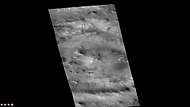Kunowsky (Martian crater)
 | |
| Planet | Mars |
|---|---|
| Coordinates | 57°06′N 9°42′W / 57.1°N 9.7°WCoordinates: 57°06′N 9°42′W / 57.1°N 9.7°W |
| Diameter | 67.4 km |
| Eponym | George K. Kunowsky, a German astronomer (1786-1846) |
Kunowsky is a large crater in the Mare Acidalium quadrangle of Mars, located at 57.1° north latitude and 9.7° west longitude. It is 67.4 km in diameter and was named after George K. Kunowsky, a German astronomer (1786–1846).[1] Because it lies on a large flat plain, Kunowsky is easy to spot on maps and pictures. It lies in the northern hemisphere just south of the very large crater Lomonosov.[2] South are hills known as Ortygia Colles.
Impact craters generally have a rim with ejecta around them, in contrast volcanic craters usually do not have a rim or ejecta deposits. As craters get larger (greater than 10 km in diameter) they usually have a central peak.[3] The peak is caused by a rebound of the crater floor following the impact.[4] If one measures the diameter of a crater, the original depth can be estimated with various ratios. Because of this relationship, researchers have found that many Martian craters contain a great deal of material; much of it is believed to be ice deposited when the climate was different.[5] Sometimes craters expose layers that were buried. Rocks from deep underground are tossed onto the surface. Hence, craters can show us what lies deep under the surface.
 Kunowsky Crater, as seen by CTX camera (on Mars Reconnaissance Orbiter).
Kunowsky Crater, as seen by CTX camera (on Mars Reconnaissance Orbiter).
See also
References
| Wikimedia Commons has media related to Kunowsky (Martian crater). |
- ↑ "Gazetteer of Planetary Nomenclature | Kunowsky". usgs.gov. International Astronomical Union. Retrieved 4 March 2015.
- ↑ Moore, P. et al. 1990. The Atlas of the Solar System. Cresent Books. NY
- ↑ http://www.lpi.usra.edu/publications/slidesets/stones/
- ↑ Hugh H. Kieffer (1992). Mars. University of Arizona Press. ISBN 978-0-8165-1257-7. Retrieved 7 March 2011.
- ↑ Garvin, J., et al. 2002. Global geometric properities of martian impact craters. Lunar Planet Sci. 33. Abstract @1255.